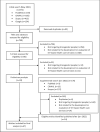Information and communication technology-based health interventions for transgender people: A scoping review
- PMID: 36962672
- PMCID: PMC10021903
- DOI: 10.1371/journal.pgph.0001054
Information and communication technology-based health interventions for transgender people: A scoping review
Abstract
In the recent past, there has been a strong interest in the use of information and communication technology (ICT) to deliver healthcare to 'hard-to-reach' populations. This scoping review aims to explore the types of ICT-based health interventions for transgender people, and the concerns on using these interventions and ways to address these concerns. Guided by the scoping review frameworks offered by Arksey & O'Malley and the PRISMA-ScR checklist, literature search was conducted in May 2021 and January 2022 in three databases (PubMed, CINAHL and Scopus). The two searches yielded a total of 889 non-duplicated articles, with 47 of them meeting the inclusion criteria. The 47 articles described 39 unique health projects/programs, covering 8 types of ICT-based interventions: videoconferencing, smartphone applications, messaging, e-coaching, self-learning platforms, telephone, social media, and e-consultation platforms. Over 80% of the health projects identified were conducted in North America, and 62% focused on HIV/sexual health. The findings of this review suggest that transgender people had often been regarded as a small subsample in ICT-based health projects that target other population groups (such as 'men who have sex with men' or 'sexual minority'). Many projects did not indicate whether transgender people were included in the development or evaluation of the project. Relatively little is known about the implementation of ICT-based trans health interventions outside the context of HIV/sexual health, in resource limiting settings, and among transgender people of Asian, Indigenous or other non-White/Black/Hispanic backgrounds. While the range of interventions identified demonstrate the huge potentials of ICT to improve healthcare access for transgender people, the current body of literature is still far from adequate for making comprehensive recommendations on the best practice of ICT-based interventions for transgender people. Future ICT-based interventions need to be more inclusive and specified, in order to ensure the interventions are safe, accessible and effective for transgender people.
Copyright: © 2022 Wong et al. This is an open access article distributed under the terms of the Creative Commons Attribution License, which permits unrestricted use, distribution, and reproduction in any medium, provided the original author and source are credited.
Conflict of interest statement
The authors have declared that no competing interests exist.
References
-
- WHO Global Observatory for eHealth. Telemedicine: opportunities and developments in Member States: report on the second global survey on eHealth. World Health Organization. Available from: https://apps.who.int/iris/handle/10665/44497
Publication types
LinkOut - more resources
Full Text Sources
Miscellaneous

